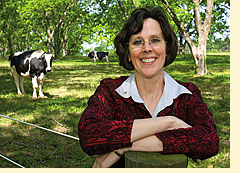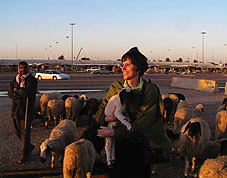Viewpoint
Animal Health is a Global Endeavor
Veterinary officials around the world are scrambling to catch up with globalization. International traffic in cattle, chickens, meat, milk, eggs, and the like, along with the flow of all kinds of other goods, has dramatically increased, driven in large part by the World Trade Organization—now 12 years old and a strong adolescent. But as animals and their products move across borders, so too can many of the pathogens they carry. Thus we are all increasingly threatened by bird flu, mad cow disease, and foot-and-mouth disease, for example, but these high-profile maladies are only a few on a growing list of invaders that may show up in new regions to wreak economic or public health havoc.
 Because countries can no longer embargo products for political reasons, the only way to keep agricultural imports out is to have a solid and justifiable scientific reason related to public or animal health. And if countries can show that they have the animal-health status required by international standards, they can export without being blocked.
Because countries can no longer embargo products for political reasons, the only way to keep agricultural imports out is to have a solid and justifiable scientific reason related to public or animal health. And if countries can show that they have the animal-health status required by international standards, they can export without being blocked.
Consequently we have major new initiatives, for developed and developing nations alike, to improve their animal health infrastructures. The developed countries are scurrying to improve detection and control methods to keep diseases out. Meanwhile, if developing countries can meet international health standards, their animal products—produced at lower cost—can be exported far and wide. Thus developing countries stand to gain the most from the globalization of agriculture—but only if they meet animal health standards. And that often means an overhaul of their veterinary infrastructure.
But how do they go about this? Donor agencies, recognizing the problem and the opportunities, are supplying funds to help countries get up to speed. Numerous training workshops provide the critical components of a modern-day animal health system, including risk-assessment techniques, decision-tree analyses, the promulgation of regulations, professional accreditation, public-private partnerships, and the development of regional control programs, to cite a few.
The Middle East, at the crossroads of three continents, is particularly vulnerable. With much of the food and animals in this region imported or exported from or to Asia, Europe, and Africa, a plethora of disease possibilities exists. Assessing imports and expanding exports, however, while critical to public health and national economies, have not been within the traditional veterinary skill set. This is the impetus for workshops that I have been helping to plan and deliver.
The past two years have taken me to the Middle East a dozen times. Each experience is unique and something I treasure. While I try to impart as much useful information as possible at each workshop, one certainty is that I gain a great deal from the participants.
From the Afghans, I have learned the larger meaning of family, where every relative is cherished and welcomed, even a distant American one with no blood ties. From the Iraqis, I have learned perseverance, as they struggle to survive and rebuild in the face of continuing conflict. The Jordanians taught me about laughter, as I sipped tea in a Bedouin tent. My hosts poked fun both at Osama bin Laden and George Bush, while organizing the cooking of a lamb to honor their American visitor.
Perhaps I have learned the most from the Palestinians and Israelis—about patience, and building a future in the face of hard political realities. Though people must stop at The Wall, birds that carry bird flu do not, nor do rabid dogs. So while diseases cross freely, there is limited mixing of Homo sapiens from either side—and that includes veterinarians. In our bilateral Israel-Palestine workshops, veterinarians from each side of The Wall have a chance to work together to build regional animal disease-control programs. They do this even though family members have been wounded or killed by those from the other country. The scenario reminds me of the post-World War II collaboration between French and German engineers. While the two governments refused to communicate, the engineers got together and developed a collaborative coal and steel industry that eventually led to a prolonged and successful peace between their countries.
Both the Israel-Palestine and French-German situations illustrate one point clearly: collaborations in science and technology can lead to important, lasting relationships—both for countries’ economies and the safety and health of their people.
Contact Corrie Brown at: corbrown@uga.edu
 |


